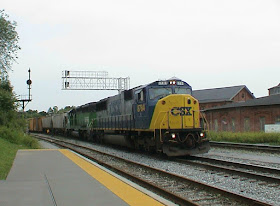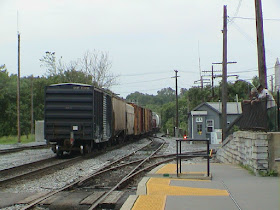In the Year 2000 there were still two great railroad main lines controlled in the traditional method with regularly spaced interlocking towers manned by block operators. The first was the Amtrak Harrisburg Line between Philly and Harrisburg, PA. The second was the B&O Main Line between Brunswick, MD and McKeesport, PA. While not as well known as the Amtrak line and also featuring a few sections of dispatcher controlled CTC, the B&O main line features a total of 8 towers which from east to west were WB (US&S Model 14, pneumatic plant with relay machines for remote interlockings),
NA Cabin in Martinsburg, WV (GRS panel relay machines),
W tower at West Cumbo (GRS Model 2 pistol grip),
R Tower at Miller, WV (mechanical),
HO tower at Hancock, WV (mechanical),
Hyndman tower (mechanical, simple crossover),
SA Tower at Sand Patch, PA (GRS Model 2 pistol Grip) and VI Tower at Connelsville (Relay CTC machine in yard office).
 |
| NA "Tower" looking east in 2004 |
The last of these, WB, closed in late 2012, but in 2003 CSX was only just finishing up its first assault on the B&O towers having just closed all but three of them . In the west SA and Hyndman got the ax. In the east it was NA, W and R (Miller). Unfortunately I managed to visit NA in January, 2004, only after it had closed. However a friend had managed to get out there shortly before the new signaling was cut over and managed to get some inside shots. NA was a tower in name only, with many people and official documents referring to it as a cabin due to its small single story construction. What was ultimately important was its status as a block and interlocking station filling the gap between HARPERS FERRY interlocking, remote WB, and W tower at West Cumbo. The operator was on hand to not only throw switches and set signals, but also hand out train orders when wrong-railing was necessary on the D-251 ABS trackage.
 |
| Plywood, fresh in 2004, would still be in place in 2014. |
It is probably easiest to explain NA by starting off inside as I don't have any other documentation to show first. NA is best described as cozy with an operator's room containing a desk and other communications equipment. NA's local interlocking, controlled by the panel above the desk, was not very complicated and I suspect that at one point it was probably operated by a
table type interlocking machine which allowed for a small single story structure. Behind the operator was a unit lever CTC-type console controlling the remote pair of crossovers at Shenandoah Junction. All main track was single direction ABS.
By 2003 NA interlocking proper consisted of one facing point crossover, #18, one turnout to a station track, #16, paired signals on both main tracks protecting the switches, 17L/R and 19L/R, and a pair controlled approach signals, 15R and 21L, for the direction of travel on both main tracks. NA was used as a terminus of the DC area commuter rail services and therefore a station track and holdout were provided to facilitate these movements. You can see on the model board that the plant has at some point been altered.
The remote plant at Shenandoah Junction was controlled by a more traditional black GRS unit lever machine. The layout is similar with two crossovers and a side track that lead to the N&W connection. Signal levers were 7R/L and 9R/L, crossovers were #10 and #14 and the connecting track #8. Also panel blocking was fitted to this panel to prevent accidental wrong railing.
Back at NA interlocking we can see one of the original CPL signals mounted on a bracket mast while a Darth cantilever hovers ovehead.
In this view of the still open NA tower we see the CPL dwarf has already been replaced by a the dwarf still in use to this day as well as the crossover that was since removed with BYRD interlocking constructed as a replacement about 2 miles to the east.
Similar shot a few months later showing the other room in the tower used for relays or maintainers.
The dwarf stack is of the G/Y/L/R design for slow speed routes. Note the distant signals to BYRD interlocking in the background.
In this rear view of NA you can see where the arm-thick pole line cable bundles used to run into the tower. Also notice the radio antenna on the room, closest to the camera man.
Wider view showing the MARC platform (accessed by the station track) and the main tracks with a passing freight train.
View of NA from across the tracks while it was still open. Here you can see an interesting quirk of B&O interlocking towers. Sometimes they were not named for the interlockings they controlled. Here the name on the local relay hut is MARTINSBURG, not NA. VI in Connellsville suffered from a similar problem locked away inside the yard tower.
When I got there only the concrete mounting blocks remained of the MARTINSBURG relay hut.
Here is a 2004 view of NA (aka MARTINSBURG) interlocking sans crossover and with only a single switch to its name. At least the point heating elements seem to be effective.
Unlike many other towers, wooden ones especially, NA seems to live a rather blessed existence so far escaping both arson and the rampaging bucket of an excavator. I'll conclude with this shot of NA Cabin in 2008 looking back towards the station from Amtrak's Capitol Limited.















No comments:
Post a Comment